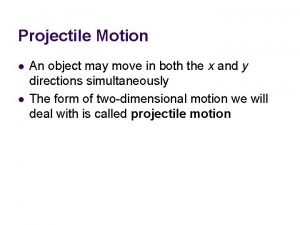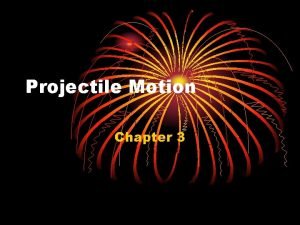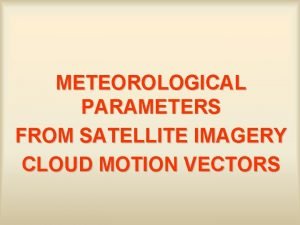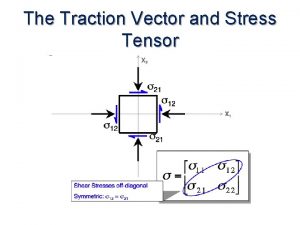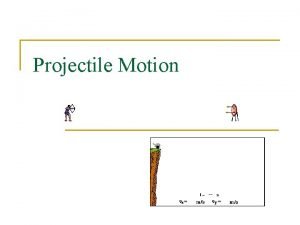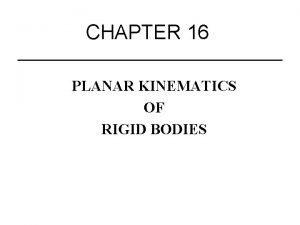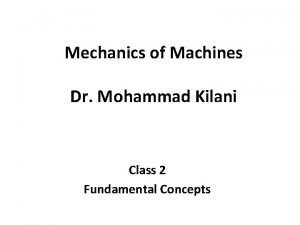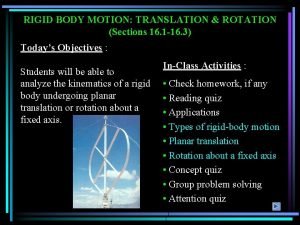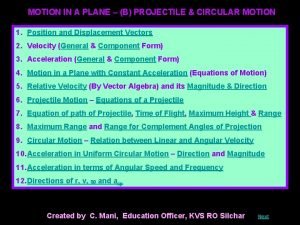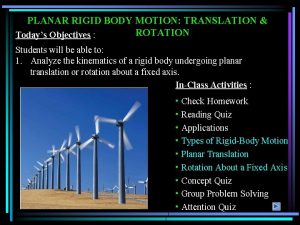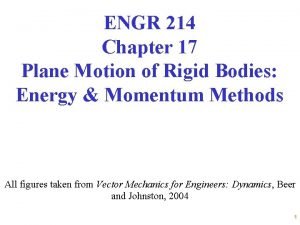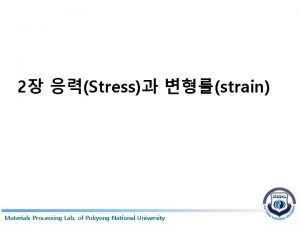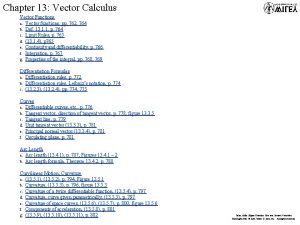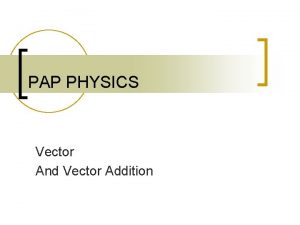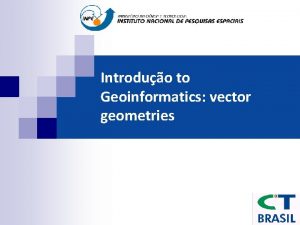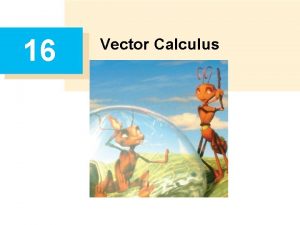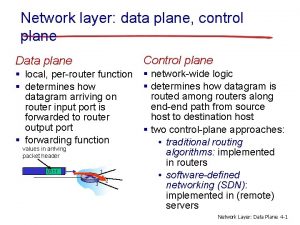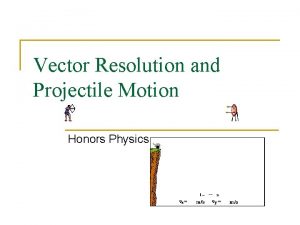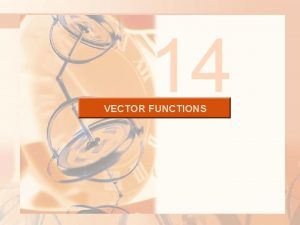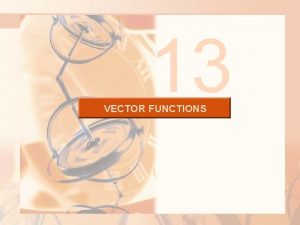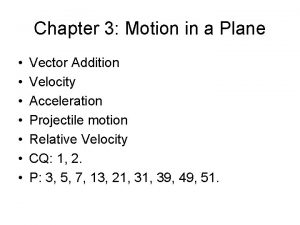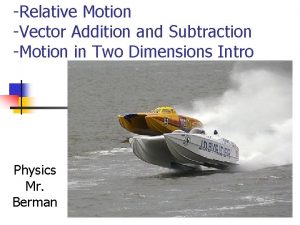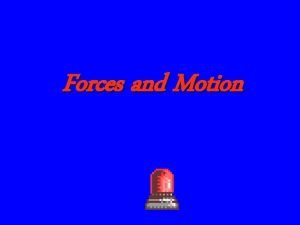Motion in a plane Vector In A Plane


























- Slides: 26

Motion in a plane

Vector In A Plane 1. Parallel Vector - If two vectors are in same direction these are called parallel vector. a b Suppose magnitude of a vector is equal to the n times then the magnitude of b vector then a = nb where n is the positive real number. If n = 1 , then a = b Then the two vectors are called equal vectors.

2. Antiparallel Vector If two vectors are in opposite direction these are called antiparallel vector. a = - nb a b The above relation denotes that – 1. The two vectors are in opposite direction. 2. The relation between magnitude is a = nb. here n is positive real number.

3. Unit Vector The vector having unit magnitude and certain direction is called unit vector. We can get the unit vector , dividing the vector by it’s magnitude. Suppose , a be a vector having magnitude a then it’s unit vector is a=a/a Generally it is used to determine the direction of a vector.

4. Coplanar Vector If two vectors lie in same plane then the vectors are called coplanar vectors. c b a Here a , b and c lie in same plane so these are coplanar vectors. It should be noted that two vectors are always coplanar.

5. Collinear Vector If two or more vectors lie on same line or support then the vectors are called collinear vectors. F 2 F 1

7. Polar Vector The vectors having defined terminating point and starting point is called polar vector. Example- Position vector 8. Axial Vector The vectors having no starting and terminating point are called axial vectors. Example – Angular velocity , Torque , Angular momentum , Angular displacement , Angular acceleration. Note - Axial vector always lie along the axis of rotation.

Law Of Vector Addition 1. Triangle law of vector addition 2. Parallelogram law of vector addition 3. Polygon law of vector addition

Triangle Law Of Vector Addition It states that if two vectors can be represent in magnitude and direction by the two sides of a triangle take in same order then the resultant is represented completely by the third side of the triangle taken in the opposite order. C R=P+Q A Q P B

Parallelogram Law Of Vector It states that if two vectors acting on a particle at the same time are represented in magnitude and direction by the two adjacent sides of a parallelogram drawn from a point , their resultant vector is represented in magnitude and direction by the diagonal of the parallelogram drawn from the same point. a b R=a+b a b

Polygon Law Of Vector Addition It states that if any number of vectors , acting on a particle at the same time are represented in magnitude and direction by various sides of an open polygon taken in the same order , their resultant is represented in magnitude and direction by the closing side of the polygon taken in opposite order. d e c a+b+c a+b b a

Analytical Method Of Triangle Law Of Vector Addition Let two vectors P and Q be represented both in magnitude and directions by the sides AB and BC of the ABC taken in the same order. Then according to triangle law of vector addition , the resultant R is given by the closing side AC taken in the opposite order. C A R Q P B E

To find the magnitude of the resultant. From C , draw CE AB , meeting AB at point E , when produced. Let CBE = O. Then , from right angled AEC , we have AC 2 = AE 2 + CE 2 = (AB + BE )2 + CE 2 =AB 2 + BE 2 + 2. AB. BE + CE 2 Now , BE 2 + CE 2 = BC 2 Therefore, AC 2 = AB 2 + BC 2 + 2. AB. BE …. 1 From right angled triangle BEC , we have cos O = BE /BC or BE = BC cos O

Therefore , equation 1 becomes AC 2 = AB 2 + BC 2 + 2. AB. BC cos. O AC = R , AB =P , BC = Q R 2 = P 2 + Q 2 + 2. PQ. cos. O R = P 2 + Q 2 + 2 PQ cos. O To find the direction of the resultant. Suppose the resultant R makes an angle with the direction of vector P. Then , from right angled AEC , we have tan = CE / AE = CE / AB+BE ……. 2

Now , AB=P , BE= Qcos. O. To find the value of CE , again consider the right angled BEC. It follows that sin. O = CE/BC CE = BCsin. O = Q sin. O From equation 2 tan = Qsin. O / P + Q cos. O

Special cases of analytical method • If O = 00 then , R = A + B • If O = 900 then , R = A 2 + B 2 • If O = 1800 then , R = ( A – B )

Law Of Sines CE AE CE = Bsin. O = Rsin …… 1 BM= Bsin. O = Asin …… 2 B From 1 R/ sin. O = B/ sin …… 3 O A From 2 B/ sin = A/ sin ……. 4 From 3 and 4 R/ sin. O = B/ sin = A/ sin B B E

Zero Vector having zero magnitude is called null vector or zero vector represented by 0. • Properties – • Addition or subtraction of zero vector from a vector is again the same vector. Example - A + 0 = A • Multiplication of non – zero real number with a zero vector is again a 0. Example - n 0 = 0

Resolution Of A vector In Three Dimensions r = xi + yj + zk E F z r = x 2 + y 2 + z 2 By polygon law – OG = OA + AB + BG O A x D G r C B y

Projectile Motion • Projectile – A particle thrown obliquely into the air is called projectile. Example – Motion of a ball , bullet in air. Air has no effect on its motion. • Trajectory – Path followed by projectile. • Projectile fired at an angle with horizontal – • Ux = ucos. O • Uy= usin. O

Motion along horizontal • Uniform unaccelerated motion Ux = ucos. O g = ax = 0 s = ut + ½ gt 2 x = ucos. O t + 1/2 X 0 X t 2 x = ucos. O t t = x/ ucos. O ……. 1

Motion along vertical • Uniform accelerated motion Uy = usin. O g = ay = -y S = uyt + ½ gt 2 y = usin. Ot + ½. –g. t 2 y = usin. Ot – ½ gt 2 ……. 2 Equation of trajectory. Put t = x/ucos. O from equation 1 to equation 2 y = usin. O. x/ ucos. O – ½ g. x 2/2 u 2 cos 2 O = xtan. O – (g/2 u 2 cos 2 O)x 2 ………This is the equation of parabola.

Time Of Flight Along y-axis V y = u y + a yt at highest point Vy = 0 0 = usin. O – gt Total time , T = 2 t T = 2 usin. O/g Maximum Height Attained Vy 2 = uy 2 + 2 gt At highest point , 0 = ( usin. O)2 – 2 gh H = u 2 sin 2 O/ 2 g

Horizontal Range s =uxt + ½ gt 2 ax = g = 0 s = R , t =T R = ucos. OT + 0 …… 1 T = 2 usin. O/g …… 2 From 1 and 2 R = ucos. O 2 usin. O/g R = u 2 2 sin. O. cos. O / g sin 2 O = 1 2 O = 900 Rmax = u 2 sin 900/ g

Uniform Circular Motion When a body follow a circular path at a constant speed , the motion of the object is called uniform circular motion. Time Period Time taken by particle to complete one round. Unit is second. Angular speed = dw/ dt = d 2 O/ dt 2 Frequency Reciprocal of time period.

Centripetal Force In circular motion a force always acts towards the center it is called centripetal force. F = ma F = mv 2/r In circular motion – 1. Direction of position vector changes continuously but magnitude remain same. 2. Direction changes continuously. 3. Acceleration acts towards center.
 Software-defined networking: a comprehensive survey
Software-defined networking: a comprehensive survey Vector resultante
Vector resultante How is vector resolution the opposite of vector addition
How is vector resolution the opposite of vector addition Vector
Vector Directed line segment definition geometry
Directed line segment definition geometry Acceleration vector projectile motion
Acceleration vector projectile motion Acceleration vector projectile motion
Acceleration vector projectile motion Is projectile
Is projectile Cloud motion vector
Cloud motion vector Sign convention for vectors
Sign convention for vectors An object in motion stays in motion
An object in motion stays in motion Motion section 1 describing motion
Motion section 1 describing motion Chapter 2 motion section 1 describing motion answer key
Chapter 2 motion section 1 describing motion answer key Types of motion
Types of motion Chapter 2 section 1 describing motion answer key
Chapter 2 section 1 describing motion answer key Measuring motion
Measuring motion Harmonic equation physics
Harmonic equation physics Describing and measuring motion worksheet answer key
Describing and measuring motion worksheet answer key Projectile motion
Projectile motion Planar kinematics of a rigid body
Planar kinematics of a rigid body Mechanics of machines
Mechanics of machines Only lines or bodies undergo angular motion
Only lines or bodies undergo angular motion R = vo^2(sin 2θ)/g
R = vo^2(sin 2θ)/g Motion in a plane
Motion in a plane A body subjected to general plane motion undergoes a/an
A body subjected to general plane motion undergoes a/an Plane motion of rigid bodies: energy and momentum methods
Plane motion of rigid bodies: energy and momentum methods Plane stress plane strain
Plane stress plane strain






